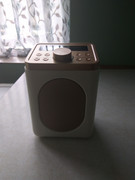First of all, don't buy the "XCSD" brand SDHC cards. Advertised as "Class 10"? No, they should be advertised as "Class 225" as in ST-225. 0.8-0.9MB/s write, 1.5-1.8MB/s read. Booting an RPi took 15 minutes and blown up, as some operations got timed out and ext4 fell apart right after resizing.
I decided to go buy more ICs, unfortunately not this Sunday, but instead I bought an old desktop AT PC casing. I have a lot of old mainboards and other components for them so I decided to make some working machines with configurations according to their age. This is an old casing from around 1991-1992, which opens to the top allowing easy servicing without fasteners. Originally it had a 386sx, and I decided to put a 386sx there: 386SX/25MHz, 2MB of RAM, 40MB IBM hard disk, Octek VGA board, 3.5 and 5.25" drives. This is a case for a late 286 or early 386.
But first, the casing was in a price of scrap materials for a reason. The front panel got torn from it, leaving only the support "tubes" broken off, still joined by screws with metal. Additionally it had to be stored in a basement standing vertically on rear, and got flooded exactly two times (what could be read from amount and shape of dried mud on it).
Fortunately these cases were not using rivets - there are screws everywhere, so I could just dismantle it entirely, wash all parts, remove rust with sandpaper where needed and put back again.
The bigger problem was with these plastic support parts. Generally after gluing them with cyanoacrylate twisting forces of a screw installed during re-assembly break this connection. So I decided to go three ways simultaneously:
1. Acetone on the inside of breaking plane as a "plastic welding" agent (its penetration time has been extended by adding a small amount of an oily solvent).
2. Cyanoacrylate to the outside of the crack. Not specifically to connect, but rather fill remaining gap and prevent crack from forming again from the smallest force.
3. Metal clamps welded in with soldering iron to take torque.
It worked very well, even with long screws!
Power supply was in a relatively good condition. There were no disastrous damages, probably because someone who took it from the basement was too afraid to plug it in. The only problems were: dry mud in the fan, blocked heatsinks, enormous amount of dirt and... every electrolytic capacitor. After testing random 5 I knew that it will be better to replace them all, as they did not look like capacitors from flowing current's perspective. All capacitors have been replaced, fan and heatsinks have been cleaned and thermal grease added. The power supply then started from the first try giving a nice, stable voltage under load.
I have spare AT power supply units, but I decided to save this one as this casing requires a special power unit with a switch on its side.
What can I say about 386SX compared to DX, is that the visible performance difference is significant. Anyone who wants to make a computer for old games will go better with a DX. The problem is not a SX's bus there, as most of these machines go well with 2..4MB of RAM, but absence of cache memory in SX.








